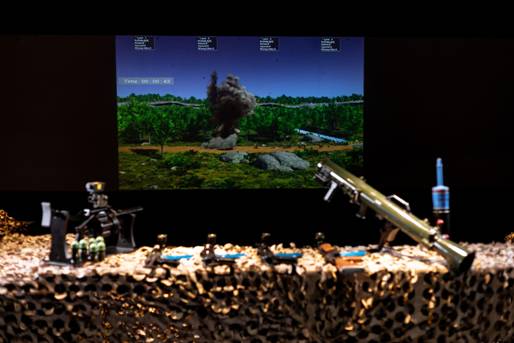Positive policies; bold actions…
In the last several years, the Govt of India has come out with many a positive policies and initiatives that have given a definitive upward push to the country’s economy. Relating it to the defence and aerospace sector, such policies have strengthened the country’s defence manufacturing capability and have given a boost to defence exports which as of Apr 2023 have surpassed a whopping 16000 Crs; a clean twenty three-fold increase from its lowly past of 686 Crs in FY 2013-141. Also, the ‘Make-in-India’ drive has moved miles beyond its ‘sloganeering’ phase and the concept of Atmanirbharta is taking roots, not merely in words alone but also, in actions that show and count.
Framework – an attempt to usher the ‘new’
Amidst this enabling environment of positive policies and bold initiatives, there one policy that will prove to be a game changer in its domain in the years to come. It is called the Framework for Simulators in the Armed Forces promulgated by the Govt in Sep 20212 Why so? Simply because, this Policy not only, breaks new ground in an attempt to usher in a ‘relatively new culture’ in the Forces, but also, by implication gives a long shot to several other ‘goodies’ such as preserving operational equipment, promoting climate change, up-skilling the armed forces, embracing the state-of-the-art…. the list can go on.
Talking of the ‘relatively new culture’, there was a time in the past when procurement deals in the Services hardly ever included the ‘simulator’ component. Even if these got included largely as an exception, the same were doomed to get the ‘axe’ on the slightest whimper of ‘cost-cutting’. Training meant training on operational equipment; period. Simulator procurement along with the main-frame equipment was mostly seen as an ‘add-on’ and not ‘integral’ or ‘inescapable’.
In recognition of the ‘simulator prowess’
The Framework attempts to change all that for it realises what simulators do; and they can do a lot really. Simulators can create reality where none exists; thanks to the enabling technologies of AI, artificial, virtual and augmented reality, 4D audio visual effects, immersive simulation and more. These can provide opportunities for unlimited simulated live and virtual fire practice giving a befitting reply to multiple challenges such as sky-rocketing cost of ammunition, shrinking field firing ranges, dwarfing training ammunition scales and their availability on the firing line.. the list can go on again. Besides, simulators deal a death-blow to the practice of ‘make-believe training’ through their ability to create realistic battlefield environment and threat conditions and ensuring ‘opposed training’ scenarios with a worthwhile adversary.
Above all, simulators provide an objective and quantified assessment of training letting the commanders know the ‘real worth’ of their troops in no uncertain terms.

Infantry Weapon Training Simulator (IWTS) by Zen Technologies Limited
https://www.google.com/search?q=IWTS++BY++ZEN+TECHNOLOGIES+LIMITED&tbm
Lofty vision clear aims
The Framework Policy in recognition of all the ‘good’ above envisions to implement simulation based training across all military domains to include combatants, leaders. maintainers, administrators, life science experts, procurement and financial agencies- the entire lot really!
It aims to lay down a framework for a synergised and enhanced exploitation of simulators for the three Armed Forces and the Coast Guard (ICG) to achieve cost-effective, safe, fast-paced and smart training. Yes, ‘smart training’ – that is quality training in minimum time and minimum cost. In short the Framework indeed captures all the virtues of training which simulators ‘make it possible. Someone has really done a comprehensive job in framing this policy!
The Policy makes HQ Integrated Defence Staff (IDS) as the nodal agency and tasks it to issue an overarching policy for optimising the use of simulators in the armed forces. The users (Forces and ICG) on their part have been tasked to formulate their policies (in alignment with HQ IDS),
identify their requirements including new areas of application of simulators, make plans for acquisition of simulators and draw out syllabus for the conduct of training.
The clarity in the Govt thought is amply visible in its alignment of the Policy to five clear goals and objectives stated unambiguously. In essence, these aim to reduce live equipment utilisation through enhanced use of simulators, going in for a phased induction of simulators through capability building plans, ushering a simulator culture by asking the Forces to include simulator requirement during planning stage itself, looking at tri-service procurements for common requirements and for interaction with the industry to enhance indigenisation – a full plate indeed!
What about industry? To say it in one word the industry is ‘simulator ready’ and is capable to fulfil every single simulator requirement of the users both current and futuristic. The Forces saw a glimpse of it as the industry more than measured up in meeting the requirement of simulators for the Agniveer training currently in progress through the Emergency Procurement (EP) mode.
Where is the doubt that the Govt has walked more than half the way in pro-actively promulgating the Framework Policy. It is indeed a laudable attempt to usher in the so called ‘a relatively new culture’. It is for the three Armed Forces and the ICG to walk the other half expeditiously. While the same is happening ‘fast’ is a matter of joy, only if it could be ‘faster’ would bring greater joy.
That it is a ‘work-in-progress’ and will catch due momentum is a firm belief of the author.
Chak-de India!